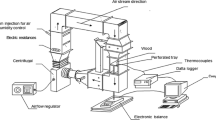Abstract
This paper presents a mathematical model developed to simulate moisture movement in lumber of Masson pine during high temperature drying. It is based on the three types of water transport in softwood during high temperature drying: (1) Liquid water movement through cell lumens and pits above fiber saturation point is assumed to be a consequence of capillary action between liquid and gas phases inside the capillary; (2) Bound water diffusion through cell-wall below the fiber saturation point is the result of the moisture content gradient across cell-wall; (3) Water vapor that moves towards the surface of wood under a partial vapor pressure gradient through the whole moisture content range during drying. The model was solved numerically to predict moisture content profiles. Experiments were undertaken to measure the moisture content gradient and used to verify the model.
Zusammenfassung
Dieses Manuskript stellt ein mathematisches Modell vor, das entwickelt wurde, um die Feuchtigkeitsbewegung in Kiefernholz während der Trocknung bei hoher Temperatur zu simulieren. Es basiert auf 3 Typen von Wassertransport bei Nadelholz während der Trocknung bei hoher Temperatur: (1) Es wird angenommen, dass die flüssige Wasserbewegung durch das Zelllumen und die Tüpfel oberhalb des Fasersättigungspunktes eine Folge der Kapillarinteraktion zwischen flüssigen Phasen und Gas-Phasen innerhalb der Kapillare ist. (2) Die Diffusion des gebundenen Wassers durch die Zellwände unterhalb des Sättigungspunktes ist das Ergebnis des Feuchtigkeitsgradienten innerhalb der Zellwand. (3) Wasserdampf, der sich unter Einwirkung eines partiellen Dampfdruck-Gradienten durch den gesamten Feuchtebereich während der Trocknung, zur Oberfläche des Holzes hin bewegt. Das Modell wurde numerisch gelöst, um die Feuchteprofile zu bestimmen. Es wurden Experimente durchgeführt, um den Feuchtigkeitsgradienten zu messen und das Modell zu verifizieren.




Similar content being viewed by others
References
Evans JM (1994) Vapor Flow in Kiln-dried Pinus radiata D. Don. 4th IUFRO International Wood Drying Conference, Rotorua, New Zealand pp 63–70
Lu J, Avramidis S (1997) Non-Darcian air flow in wood-part 1:Specimen length effect. Holzforschung 51(6):577–853
Miao P (2000) Predicting M.C. of lumber during wood drying with small sample: Applying unstated-state diffusing of water in wood. China Wood Industry 14 (3):24–26
Miao P (2000) Water movement and heat transfer of Masson pine lumber during high temperature drying. Ph.D. thesis, University of Naijing forestry, China
Perré P, Fohr JP, Arnaud G (1988) A model of drying applied to softwood: The effect of gaseous pressure above the boiling point. Proc. Sixth International Drying Symposium IDS'88, Versailles, pp 279
Plumb OA, Spolek GA, Olmstead BA (1985): Heat and mass transfer in wood during drying. Int. J. Heat mass transfer, 28(9):1669–1678
Stanish MA (1986) The roles of bound water chemical potential and gas phase diffusion in moisture transport through wood. Wood Science & Technology, 19(1):53–70
Author information
Authors and Affiliations
Corresponding author
Rights and permissions
About this article
Cite this article
Ping, M., Lianbai, G. Water transfer of Masson pine lumber during high temperature drying. Holz Roh Werkst 61, 349–354 (2003). https://doi.org/10.1007/s00107-003-0383-8
Published:
Issue Date:
DOI: https://doi.org/10.1007/s00107-003-0383-8




